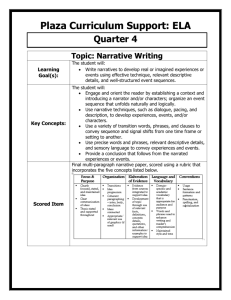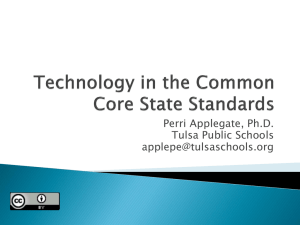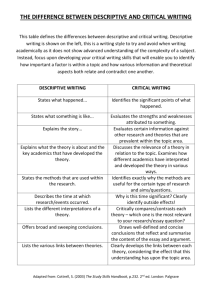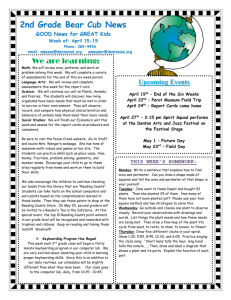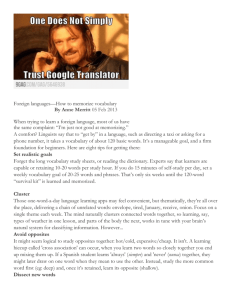Narrative Writing Rubric
advertisement
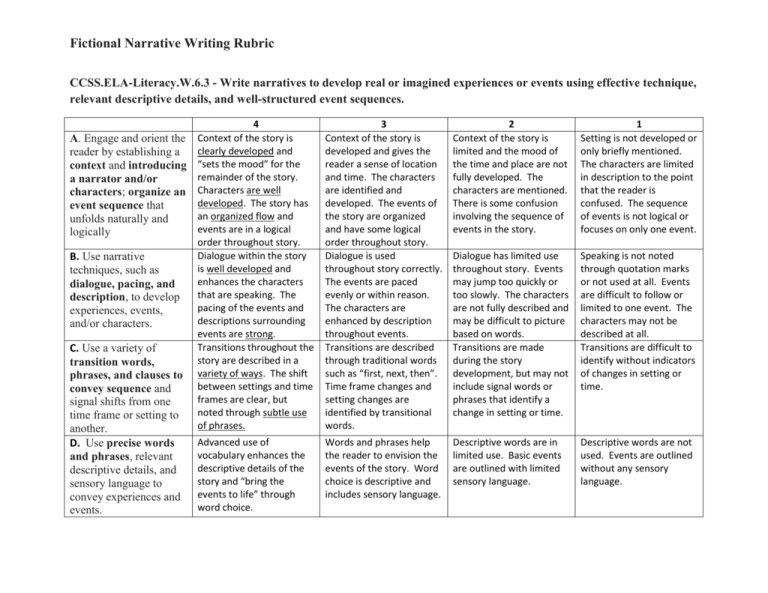
Fictional Narrative Writing Rubric CCSS.ELA-Literacy.W.6.3 - Write narratives to develop real or imagined experiences or events using effective technique, relevant descriptive details, and well-structured event sequences. A. Engage and orient the reader by establishing a context and introducing a narrator and/or characters; organize an event sequence that unfolds naturally and logically B. Use narrative techniques, such as dialogue, pacing, and description, to develop experiences, events, and/or characters. C. Use a variety of transition words, phrases, and clauses to convey sequence and signal shifts from one time frame or setting to another. D. Use precise words and phrases, relevant descriptive details, and sensory language to convey experiences and events. 4 Context of the story is clearly developed and “sets the mood” for the remainder of the story. Characters are well developed. The story has an organized flow and events are in a logical order throughout story. Dialogue within the story is well developed and enhances the characters that are speaking. The pacing of the events and descriptions surrounding events are strong. Transitions throughout the story are described in a variety of ways. The shift between settings and time frames are clear, but noted through subtle use of phrases. 3 Context of the story is developed and gives the reader a sense of location and time. The characters are identified and developed. The events of the story are organized and have some logical order throughout story. Dialogue is used throughout story correctly. The events are paced evenly or within reason. The characters are enhanced by description throughout events. Transitions are described through traditional words such as “first, next, then”. Time frame changes and setting changes are identified by transitional words. 2 Context of the story is limited and the mood of the time and place are not fully developed. The characters are mentioned. There is some confusion involving the sequence of events in the story. 1 Setting is not developed or only briefly mentioned. The characters are limited in description to the point that the reader is confused. The sequence of events is not logical or focuses on only one event. Dialogue has limited use throughout story. Events may jump too quickly or too slowly. The characters are not fully described and may be difficult to picture based on words. Transitions are made during the story development, but may not include signal words or phrases that identify a change in setting or time. Speaking is not noted through quotation marks or not used at all. Events are difficult to follow or limited to one event. The characters may not be described at all. Transitions are difficult to identify without indicators of changes in setting or time. Advanced use of vocabulary enhances the descriptive details of the story and “bring the events to life” through word choice. Words and phrases help the reader to envision the events of the story. Word choice is descriptive and includes sensory language. Descriptive words are in limited use. Basic events are outlined with limited sensory language. Descriptive words are not used. Events are outlined without any sensory language. Fictional Narrative Writing Rubric The conclusion shows an E. Provide a conclusion The conclusion shows a comprehensive understanding of events that follows from the understanding of the key and sequences them in a narrated experiences or points in the story. concluding paragraph. events. CCSS.ELA-Literacy.W.6.4-5 – Production and Distribution of Writing 4. Produce clear and coherent writing in which the development, organization, and style are appropriate to task, purpose, and audience. 5. With some guidance and support from peers and adults, develop and strengthen writing as needed by planning, revising, editing, rewriting, or trying a new approach. 6. Use technology to produce and publish writing as well as to interact and collaborate with others; demonstrate sufficient command of keyboarding skills to type a minimum of three pages in a single sitting. Produces clear and coherent writing in which the development, organization and style are advanced in skill level and engaging to the audience. The writing is well suited to task and purpose. Independently develop and strengthen writing as needed by planning, revising, editing, rewriting, or trying a new approach. Use technology to produce and publish writing as well as to interact and collaborate with others; demonstrate sufficient command of keyboarding skills to type a minimum of four pages in a single sitting. Produce clear and coherent writing. The development, organization, and style are appropriate to task. The writing meets the purpose and addresses the needs of the audience. With some guidance and support from peers and adults, develop and strengthen writing as needed by planning, revising, editing, rewriting, or trying a new approach. Use technology to produce and publish writing as well as to interact and collaborate with others; demonstrate sufficient command of keyboarding skills to type a minimum of three pages in a single sitting. The conclusion outlines some of the events of the story and may or may not follow the sequence. The conclusion is either missing or not in a recognizable order of events. Produces a writing that is partly clear. Some of the organization is present. The style is appropriate to the task and purpose. The audience may or may not be addressed appropriately. With significant guidance and support from peers and adults, develop and strengthen writing as needed by planning, revising, editing, rewriting, or trying a new approach Use technology to produce and publish writing as well as to interact and collaborate with others; demonstrate sufficient command of keyboarding skills to type a minimum of two pages in a single sitting. Writing is unclear. The organization is missing. The style is inappropriate to the task and purpose. The audience is not considered in the development of the story. With significant guidance and support from peers and adults, unable to develop and strengthen writing through various stages of writing enough to meet standards. Limited use of technology to produce and publish writing as well as to interact and collaborate with others; demonstrate 1 or less page in a single sitting. Fictional Narrative Writing Rubric
